
If this is showing on the site, the Archived items aren't filtering out.
- Subject:
- History
- Material Type:
- Lesson Plan
- Author:
- National Air and Space Museum
- Date Added:
- 06/14/2022


If this is showing on the site, the Archived items aren't filtering out.

An introduction to some common everyday symbols and the use of symbols in aviation and space flight.
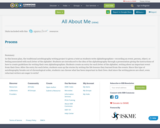
In this lesson plan, the traditional autobiography writing project is given a twist as students write alphabiographies—recording an event, person, object, or feeling associated with each letter of the alphabet. Students are introduced to the idea of the alphabiography through a presentation giving the instructions of how to create guidelines for writing their own alphabiographies. Students create an entry for each letter of the alphabet, writing about an important event from their lives. After the entry for each letter, students sum up the stories by writing the life lessons they learned from the events. Since this type of autobiography breaks out of chronological order, students can choose what has been important in their lives. And since the writing pieces are short, even reluctant writers are eager to write!
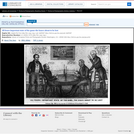
The presidential campaign of 1836 viewed as a card game by a satirist in sympathy with the Whigs. Opposing candidates Martin Van Buren (Democrat) and William Henry Harrison (Whig) face each other across a card table. Behind Van Buren stands his vice-presidential running mate Richard M. Johnson. Behind Harrison is incumbent President Andrew Jackson, who smokes a clay pipe and stands on tip-toes to spy on Harrison's hand. With his left hand he signals to Van Buren. Jackson: "What a h---ll of a hand old Harrison's got. I'm afraid Martin and Dick Johnson will go off with a flea in their ear." Johnson: "The old general is making signs that Harrison has the two highest trump cards and low. Martin he'll catch your Jack and then the jig's up! You'd better beg." Van Buren: "I ask one." Harrison: "Take it! now look out for your Jack!" On the wall above the table is a painting of the Battle of the Thames, one of Harrison's celebrated military victories a well as the occasion on which Johnson is reported to have slain the Indian chief Tecumseh. The print is probably by Robinson draughtsman Edward W. Clay, judging from its similarity to his "Grand Match Between the Kinderhook Poney ..." (no. 1836-14) and other signed work of the period.|Entered . . . 1836 by H.R. Robinson.|Published May 1836 by the proprietor H.R. Robinson, 48 Cortlandt St. N. York.|Title appears as it is written on the item.|Weitenkampf, p. 44.|Forms part of: American cartoon print filing series (Library of Congress)|Published in: American political prints, 1766-1876 / Bernard F. Reilly. Boston : G.K. Hall, 1991, entry 1836-11.

The major figures in American national politics in 1838 are gently satirized, each characterized as riding a favorite issue or "hobbyhorse." At the lead (far left) is President Martin Van Buren, riding a horse "Sub-Treasury," which he calls his "Old Hickory nag." The artist refers to Van Buren's independent treasury program, a system whereby federal funds were to be administered by revenue-collecting agencies or local "sub-treasuries" rather than by a national bank. The Independent Treasury Bill was perceived as an outgrowth of predecessor Jackson's anti-Bank program. Another hobbyhorse, "United States Bank" (center), is shared by Whig senators Henry Clay and Daniel Webster, leaders of congressional opposition to Jackson and Van Buren's respective fiscal agendas. Clay says, "Either you or I must get off Dan, for this horse wont carry double!" Webster responds, "Dash my Whig if I get off Hal!" Directly behind Van Buren Democratic Senator Thomas Hart Benton rides a horse "Specie Currency," an allusion to Benton's championing of hard money economics. Benton was identified with administration efforts to curb the use of currency in favor of "specie" or coin, and to increase the ratio of gold to silver in circulation. He says, "My Golden Poney carries more weight than any of them!" Behind Clay and Webster is South Carolina senator John C. Calhoun, advocate of state's rights and the driver of Southern nullification of the "Tariff of Abominations." On the right are William Henry Harrison, in military uniform and riding an "Anti-Masonic" hobby, and Massachusetts Congressman John Quincy Adams on his "Abolition" mount. Harrison's horse is named after the party which supported his 1836 bid for the Presidency. When he says, ". . . unless there is another Morgan abduction, I'm afraid he'll [the horse] lose his wind!" he alludes to the suspicious 1826 death of William Morgan (purportedly at the hands of Masons) which fueled considerable anti-Masonic sentiment in the United States. Adams laments, "This horse, instead of being my Topaz, is my Ebony." |Entd . . . 1838 by H.R. Robinson.|Printed & publd. by H.R. Robinson, 52 Cortlandt St. N.Y.|Signed with monogram: C (Edward Williams Clay).|The print was registered for copyright on March 16, 1838.|Title appears as it is written on the item.|Blaisdell and Selz, no. 16.|Davison, no. 104.|Weitenkampf, p. 53.|Forms part of: American cartoon print filing series (Library of Congress)|Published in: American political prints, 1766-1876 / Bernard F. Reilly. Boston : G.K. Hall, 1991, entry 1838-1.
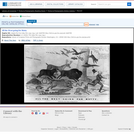
A Whig cartoon spoofing Democratic claims of Western support for Van Buren during the election of 1840. Pursued by animals from the "Alleghany Mountains" and the Mississippi River, including among others a buffalo, alligator, beaver, turtle, and fox, Van Buren flees to the right saying, "This is going for me with a vengeance! I wish I was safe at Kinderhook! [his birthplace and family home was Kinderhook, New York] for I am a used up man!" A parchment "Sub-Treasury Bill" has fallen at his feet, referring to the independent treasury plan, the centerpiece of Van Buren's fiscal program.|Entered . . . 1840 by J. Childs.|Published by John Childs, 90 Nassau St. N.Y.|Signed with monogram: EWC (Edward Williams Clay).|Title appears as it is written on the item.|Weitenkampf, p. 61.|Forms part of: American cartoon print filing series (Library of Congress)|Published in: American political prints, 1766-1876 / Bernard F. Reilly. Boston : G.K. Hall, 1991, entry 1840-53.
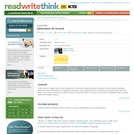
Students learn about alliteration, and then practice using alliteration in acrostic poems, tongue twisters, alphabet books, and number books.
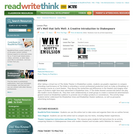
Students compare attending a performance at The Globe Theater with attending a modern theater production or movie. They then create a commercial for an Elizabethan audience promoting a modern product.
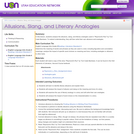
In this lesson, students analyze the allusions, slang, and literary analogies used in "Raymond's Run" by Toni Cade Bambara. To extend understanding, they will then write their own allusions and analogies.
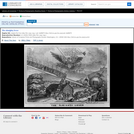
E. W. Clay's apocalyptic allegory has public opinion as a giant lever, tilting decisively in favor of the Whigs late in the presidential campaign of 1840. In a symbolic landscape masses of people climb onto the lever, which then nudges the great ball of "Loco Focoism" over a precipice. In the sky appears an eagle with a shield, arrows, and olive branches, holding a banner with the commentary: "With a log cabin and barrel of hard Cider for a fulcrum, public opinion for a "lever," with old Tip on the tip end the ball of Locofocoism will be rolled into oblivion and a gallant soldier raised to the white house. March 4th 1841." In the distance is a recently cleared field, the White House, and the Capitol. Van Buren and several others topple from the giant ball, on which also appears a strong box inscribed "Sub Treasury." A crowd of erstwhile supporters flee from the edge of the chasm, leaving behind "Treasury Notes." The print probably appeared in September 1840, since the Library's impression was deposited for copyright on September 24. Nancy Davison and Frank Weitenkampf both attribute the print to Edward W. Clay. This is supported by stylistic comparison with his other 1840 cartoons. The "W.C." signature appears to be a truncated form of his "EWC" monogram.|Entered . . . 1840 by J. Childs.|Published by John Childs, 90 Nassau Street New York.|Signed: W.C. inv. (Edward Williams Clay).|Title appears as it is written on the item.|Davison, no. 133.|Lorant, p. 158-159.|Weitenkampf, p. 66.|Forms part of: American cartoon print filing series (Library of Congress)|Published in: American political prints, 1766-1876 / Bernard F. Reilly. Boston : G.K. Hall, 1991, entry 1840-58.
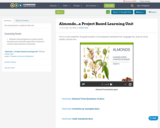
See attachments to replicate this unit.

This resource allows students to learn the letters of the alphabet, the sound of the letters, and words that start with each letter. In addition, students can acquire new vocabulary. To carry out this activity, it is important to first watch this video:https://www.youtube.com/watch?v=RlpeUVw43vU .It features a song where the alphabet letters are learned through a story. Subsequently, students will create the first slide where they can listen to the letters by clicking on them. The teacher will make a sound or say the letters, and the students have to drag them onto the coconut tree. Next, a song https://www.youtube.com/watch?v=hq3yfQnllfQ will play where the sounds of the letters are associated with words, and students have to repeat them. Finally, on the other slides, there is vocabulary worked on in this song, so if the drawings related to the letter 'c' appear, they have to click on the letter 'c'.
Finally, to create this resource, I drew inspiration from Drahota Brandee: https://oercommons.org/courseware/lesson/70494
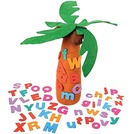
This Remote Learning Plan was created by Brandee Drahota in collaboration with Rick Meyer as part of the 2020 ESU-NDE Remote Learning Plan Project. Educators worked with coaches to create Remote Learning Plans as a result of the COVID-19 pandemic.The attached Remote Learning Plan is designed for preschool students. This alphabet lesson uses the story Chicka Chicka Boom Boom by Bill Martin, Jr. and John Archambault as an introduction to alphabet identification.
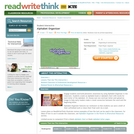
Students use this online tool to create an alphabet chart or pages for an alphabet book.
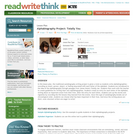
The traditional autobiography writing project is given a twist as students write alphabiographies - recording an event, person, object, or feeling associated with each letter of the alphabet.
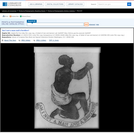
The large, bold woodcut image of a supplicant male slave in chains appears on the 1837 broadside publication of John Greenleaf Whittier's antislavery poem, "Our Countrymen in Chains." The design was originally adopted as the seal of the Society for the Abolition of Slavery in England in the 1780s, and appeared on several medallions for the society made by Josiah Wedgwood as early as 1787. Here, in addition to Whittier's poem, the appeal to conscience against slavery continues with two further quotes. The first is the scriptural warning, "He that stealeth a man and selleth him, or if he be found in his hand, he shall surely be put to death. "Exod[us] XXI, 16." Next the claim, "England has 800,000 Slaves, and she has made them free. America has 2,250,000! and she holds them fast!!!!" The broadside is advertised at "Price Two Cents Single; or $1.00 per hundred.|N.Y. sold at the Anti-Slavery Office, 144 Nassau St. 1837.|Title appears as it is written on the item.|Wedgwood Portraits and the American Revolution, p. 116-117.|Published in: American political prints, 1766-1876 / Bernard F. Reilly. Boston : G.K. Hall, 1991, entry 1837-16.

Through a close reading of "Amelia Bedelia", students reread the material to discuss text-dependent questions, promoting deep thinking about the text and its characters.
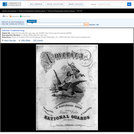
An allegorical illustration on the cover of a patriotic song, dedicated to the "National Guards of Philadelphia." A pronouncedly decollete Columbia or Liberty figure sits astride a bald eagle which flies over the globe. The eagle clutches lightning bolts and an olive branch in its talons, while Columbia holds a scroll (probably the Constitution) and an American flag.|Entered . . . 1859 by Lewis Dela . . . Pennsylvania.|Lewis N. Rosenthal Lith. Phila.|Philadelphia, Lee & Walker, 722 Chestnut Street.|The Library's copy of the music cover was deposited for copyright on September 15, 1859.|Title appears as it is written on the item.|Published in: American political prints, 1766-1876 / Bernard F. Reilly. Boston : G.K. Hall, 1991, entry 1859-2.
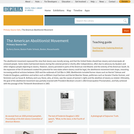
This collection uses primary sources to explore the American Abolitionist Movement. Digital Public Library of America Primary Source Sets are designed to help students develop their critical thinking skills and draw diverse material from libraries, archives, and museums across the United States. Each set includes an overview, ten to fifteen primary sources, links to related resources, and a teaching guide. These sets were created and reviewed by the teachers on the DPLA's Education Advisory Committee.
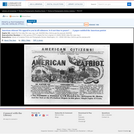
An advertisement announcing publication of the "American Citizen," a short-lived nativist newspaper. The broadside is illustrated with an elaborate and venomous anti-Catholic scene. At left a temple of Liberty stands on a mound labeled "Constitution and Laws." At the foot of the hill is a gathering of native Americans, including sailors, farmers, soldiers, and a Revolutionary War veteran. They hold banners emblazoned with such mottoes as "The Bible The Cornerstone of Liberty," "Beware of Foreign Influence," "None But Americans Shall Rule America," and "Education, Morality, and Religion." Other banners bear the names of sites of great revolutionary battles. In the background are a harbor with ships and the skyline of a city. In contrast, an unruly contingent of foreigners, mostly Irish, alight from a newly landed ship at right. The ship, "from Cork," bears the papal coat of arms. The foreigners carry banners reading, "We Are Bound to Carry Out the Pious Intentions of His Holiness the Pope," "Americans Shant Rule Us!!" and "Fradom of Spache and Action!" Among them are several clerics, a drunken mother with several children, and a few unkempt ruffians. One of the newcomers (lower right) beats a man with a club. In the distance, across the ocean, the basilica of St. Peter's in Rome is visible. From it issues a giant basilisk wearing the pope's crown, which is seized by a large hand from above. A commentary is provided in the lengthy continuation of the title: "Already the enemies of our dearest institutions, like the foreign spies in the Trojan horse of old, are within our gates. They are disgorging themselves upon us, at the rate of Hundreds of Thousands Every Year! They aim at nothing short of conquest and supremacy over us." Below the illustration the text states that the "American Patriot" favors "protection of American Mechanics Against Foreign Pauper Labor. Foreigners having a residence in the country of 21 years before voting, Our present Free School System, and Carrying out the laws of the State, as regards sending back Foreign Paupers and Criminals." The paper opposes "Papal Agression & Roman Catholicism, Foreigners holding office, Raising Foreign Military Companies in the United States, Nunneries and Jesuits, To being taxed for the support of Foreign paupers millions of dollars yearly To secret Foreign Orders in the U.S." |The Patriot is published by J.E. Farwell & Co., 32 Congress St., Boston, and for sale at the Periodical Depots in this place.|Title appears as it is written on the item.|Purchase; Caroline and Erwin Swann Memorial Fund.|Forms part of: American cartoon print filing series (Library of Congress)|Published in: American political prints, 1766-1876 / Bernard F. Reilly. Boston : G.K. Hall, 1991, entry 1852-3.